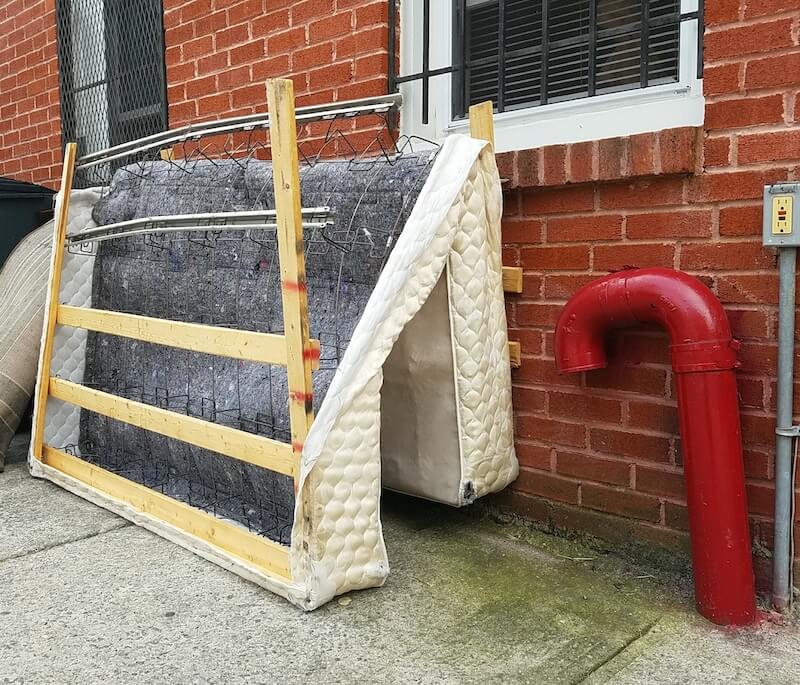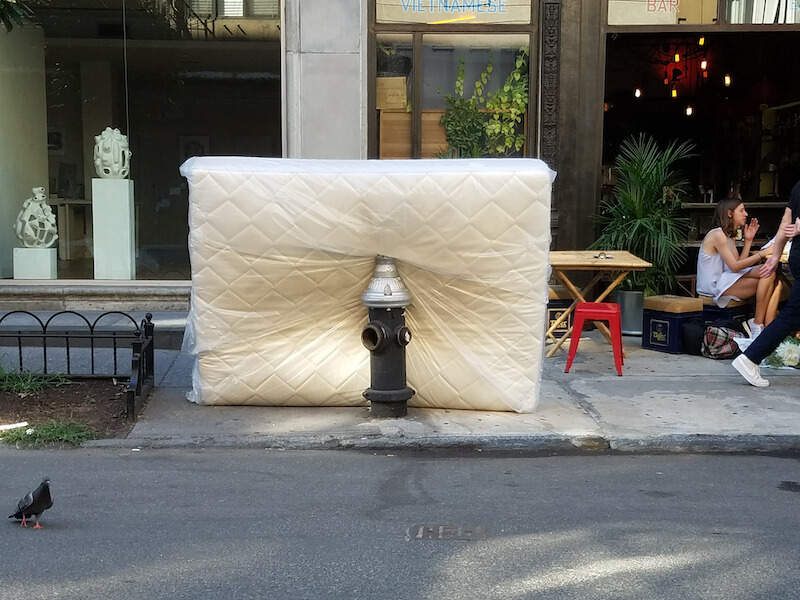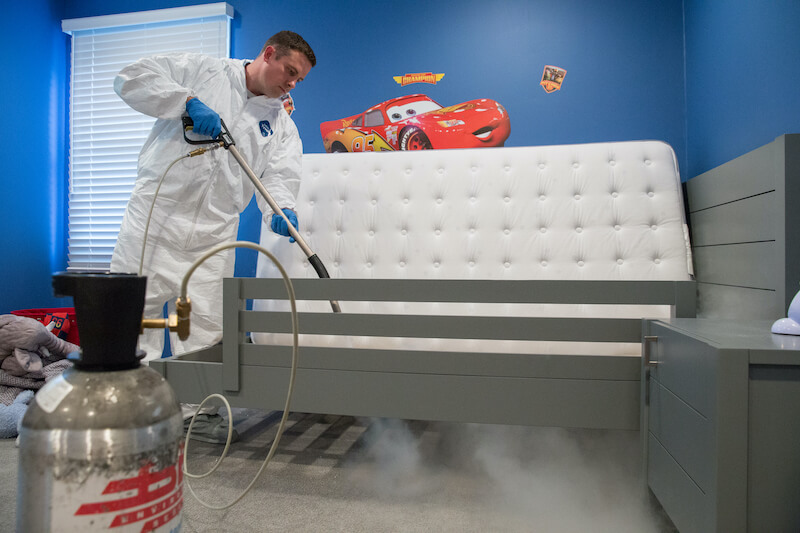- Are bed bugs covered by renters insurance?
- Is my landlord responsible for treating bed bugs?
- How do you get bed bugs?
- What do bed bugs look like, and what signs do they leave?
- What should your first step be if you find bed bugs?
- How do you get rid of bed bugs?
- How much does bed bug treatment cost?
- What are the 10 worst cities for bed bugs?
- How can I prevent getting bed bugs in the first place?
- Are there traps or monitors that are helpful for bed bug control?
- Bed bug FAQs
Your renters insurance policy probably doesn’t cover bed bug extermination or treatment—although it’s likely that your landlord would be responsible for organizing and paying for an exterminator.
A bed bug infestation can be hard to detect, and equally hard to eradicate. That’s not to mention the embarrassing social stigma they come with! Just tell a friend you’re dealing with these pests and see how quickly they run screaming from the room…

Bed bugs can turn your cozy, warm apartment into the set of a low-budget horror movie. But what can feel like an insurmountable, never-ending disaster is actually a manageable pain in the ass. Promise.
Below, we’ll crawl deep into everything you need to know about bed bugs, from whether your renters insurance will cover the pests to how to detect them and then get them out of your life.
Are bed bugs covered by renters insurance?
Bed bug treatments are not covered by most renters insurance, including Lemonade’s, as they’re likely not a “covered peril” that your policy protects against. That means you probably won’t be able to file an insurance claim to cover the cost of extermination.
This also means your policy’s Loss of Use coverage would not help cover additional living expenses if you have a bed bug issue and want to leave your apartment for a period of time.
Is my landlord responsible for treating bed bugs?
Generally, yes, it would be your landlord’s responsibility to pay for treatments for bed bugs (as well as other pests, like termites, mice, or other vermin).
Of course, just because the law says one thing doesn’t mean that the process will go smoothly. It’s another reason to have a productive and amicable relationship with your landlord—while dealing with a bed bug infestation, you probably don’t also want to go to court to get it paid for.
The EPA has a handy list that breaks down various bed bug-related rules and regulations by state.
How do you get bed bugs?

You can get bed bugs from almost anywhere—while traveling, on public transit, in a movie theater.
Bed bugs aren’t a byproduct of uncleanliness, and they don’t have a class bias. The bed bug will be just as at home in a fancy hotel or Manhattan brownstone as they are in the most rundown tenement.
Bed bugs are known as “hitchhikers,” which means that they’re keen to travel from one place to another.
These insects can set up shop in a ton of sneaky places: baseboards; used furniture other than beds; electrical outlets; the crevices of that picture frame you bought at the Goodwill; the spines of hardcover books.
Once even a single bug is introduced into an apartment building with multiple units, an untreated problem can spread—across the hall, or between floors, using heating pipes to travel.
What do bed bugs look like, and what signs do they leave?

One of the more maddening things about bed bugs is how sneaky they are, and how well they avoid simple detection.
There’s a common myth that bed bugs are somehow so small that they’re essentially invisible. While the smallest bed bug nymphs are very tough to spot, you don’t need a microscope to see bed bugs. That said, they do secret themselves away in places where you’re not likely to find them, unless you’re looking.
So what hiding places should you take a peek at, and what are the signs of bed bugs?
- Your mattress is a good enough place to start. Inspect the seams, corners, and other areas for live bugs, the shed “skins” of bugs (their exoskeletons), or suspicious black markings that are actually a bed bug’s fecal droppings. The latter are often described as looking like a black marker tip bled into the fabric.
- Sometimes you might also see blood spots or stains on your actual bedding. As promised, we’re not embedding any of these gnarly images here, but feel free to click the links to see real-life examples (or dive into Google’s endless array of stomach-turning pics).
- It’s equally important to closely inspect your box spring, if you have one—or any platform, bed frame, or support that your mattress rests on. Use a credit card to poke at any cracks or crevices in the box spring, and a flashlight to get a better look.
- From there, expand your search outward from the bed: side tables, other furniture, framed objects on the walls, your bed’s headboard.
But keep in mind that bed bugs can and will set up shop in places other than your bedroom. If you spend a lot of time lounging on your living room couch watching Netflix—plenty of time for a few parasites to take a nibble—then your problem might be localized there.
What should your first step be if you find bed bugs?
If you find a live bed bug or signs of bed bugs in your apartment, you might panic. The important thing is not to make rash decisions that will cause bigger problems later.
“Many bed bug victims’ first instincts are to get the jitters and then figure out ways to get rid of these little vampires as quickly as possible,” explains Glenn Waldorf, of the New Jersey-based bed bug exterminators Bell Environmental.
“Peoples’ minds race and they think, ‘Should I throw out our furniture? How can I ever sleep in this bed again? I’ll just move to the couch. Maybe I should spray the room with cleaning supplies, chemicals and/or bleach—that will kill them!’ Please don’t do any of those things. These actions can make your bed bug problem worse and harder to resolve.”
The last thing you want to do is freak out and decide to drag your infested, unwrapped mattress through your apartment building and out to the curb.
Waldorf says to “take a deep breath” and remain calm.
- Photograph whatever insects you find, or trap them for identification. If you can’t figure out what you’re looking at, there are entomologists online who are often willing to identify bugs, or suspicious markings that might be fecal droppings.
- If you indeed have a problem on your hands, call a pest control professional who can come draft a proper treatment plan—one that likely might not even involve tossing out your bed or other furniture.
- If you do decide to dispose of an infected mattress or boxspring at any point in time, do yourself and your building mates a favor: Wrap it up very, very securely in a special plastic bag before removing it from your apartment.
How do you get rid of bed bugs?
Getting rid of bed bugs is challenging, but manageable. Once you’ve got the green light to work with a trustworthy pest control company, you’ll have to decide which type of treatment you’re comfortable with.
There are many, from chemical treatments to extermination efforts that use extreme heat or extreme cold. Many companies will mix tactics for a hybrid method that includes both physical and chemical solutions.
Any treatment will also involve a lot of legwork on your part, helping to prepare your apartment and your stuff according to specific directions your pest control provider will give you.
This will likely involve:
- Vacuuming everywhere
- Decluttering your place
- Running clothes and linens through the dryer on medium-high heat
- Storing certain belongings in sealable plastic bags for a period of time
Some pest control companies will lay down pesticides that kill bed bugs. Others will bring heavy equipment into your home for heat treatment, generating high temperatures throughout the entire living space so that bugs at various life stages will be killed off.
Bell Environmental uses a non-toxic technology known as InstantFreeze—as you might guess, it involves blasting furnishings, bed frames, box springs, and other hiding places and belongings with ultra-cold dry ice spray, killing bugs.

There are almost as many treatment options as there are bed bug hiding places.
Caulk can be applied to cracks in walls, ceiling, baseboards, or around pipes, to eliminate avenues for bed bugs to travel in or out.
Organic powders, like diatomaceous earth, might be useful in some instances (and when properly applied).
How much does bed bug treatment cost?
The cost of bed bug treatment will depend on the extent of the problem, the size of your home, the treatment style you choose, and where you live.
That said, below is a helpful estimate of the costs you might expect to face.
| # of rooms | Average cost |
|---|---|
| 1 | $350–$500 |
| 2 | $800–$950 |
| 3 | $1,100–$1,350 |
| 4 | $1,600–$1,800 |
| Whole house | $3,800–$8,000 |
What are the 10 worst cities for bed bugs?
Bed bugs can strike nearly anywhere. And while New York City usually gets a bad rap for being a bed bug hotspot, some studies actually point to Chicago as the worse pest epicenter.
Here’s where the bed bug problem is the most out of control, according to the pest experts at Terminix.
- Philadelphia
- New York
- Cleveland-Akron, OH
- Los Angeles
- Dallas-Ft. Worth, TX
- Atlanta
- Houston
- Washington, D.C.
- San Francisco-Oak-San Jose, CA
- Indianapolis
How can I prevent getting bed bugs in the first place?
There’s no 100%-guaranteed way to prevent bed bugs. But you can follow common sense practices:
- Avoid bringing backpacks or purses into movie theaters.
- Check reviews and listings of hotels to see if they’ve had bed bug complaints.
- When staying in a hotel or Airbnb, don’t keep luggage or belongings right next to the bed—consider stowing it further away, or even in the bathroom.
- Never pick up furniture from the street (that includes wooden chairs).
Are there traps or monitors that are helpful for bed bug control?
Yes. Unsurprisingly, there’s a whole cottage industry dedicated to anti-bed-bug doodads and equipment. These include:
- Glue traps to place in key locations around your apartment
- “Active” monitors that release CO2 to mimic a human presence, drawing out pests from hiding spots
- Round, plastic interceptors—like those made by ClimbUp—which can be placed under furniture legs, intended to capture any bugs.
- “Passive” monitors, basically small gadgets that are tucked under the mattress and provide a tempting place for any bed bugs to hide out in (and leave easy-to-see signs of their presence)
- Mattress encasements cover your mattress, and make it difficult for any bugs to tuck themselves into its seams or crevices. (Just make sure that the encasement itself doesn’t rip—like if your cat loves to claw your bed.)
Find the right solution that works for your situation, and your mental health. If you travel often, and are worried about picking up bed bugs from a hotel room or Airbnb, you might consider a heating device that can treat your luggage, hopefully killing any live bed bugs or eggs that might have joined you along the way.
Bed bug FAQs
How can I avoid bringing bed bugs with me to work, or to a friend’s apartment?
As if they’re not bad enough, bed bugs are also fond of traveling with you when you leave your apartment.
- Be cognizant of what you bring with you when you head out the door.
- While you’re in the process of treatment, consider keeping your clothing and other belongings in sealable plastic bags, like these.
- Don’t leave shoes, purses, or other items near your bed or on other furniture.
- Talk to your neighbors if you’re experiencing a bed bug issue! Proper treatment of bed bugs requires dealing with issues in any neighboring apartments, so that the pests don’t simply ping-pong from one location to another.
Can bed bugs live in any room?
Can dogs detect bed bugs?
This can be a controversial topic, but specially trained dogs are often used to detect small bed bug infestations that humans could miss.
A K-9 inspection service would send a qualified dog and handler to your property. These pups are talented when it comes to sniffing out hard-to-spot bed bug populations—but it’s also possible that they might fail to alert in the presence of an infestation, or alert falsely or ambiguously when you actually don’t have bed bugs.
The general rule of thumb is not to take a positive K-9 inspection result at face value, until a handler or exterminator can physically locate signs of bed bugs in the apartment.
Can you identify bed bugs by their bites?
Unfortunately not. While the popular consensus is that bed bug bites have a specific appearance, and most often appear in rows of three (aka a “breakfast, lunch, and dinner” pattern), the truth is that it’s basically impossible to confirm a bed bug infestation based on whatever itchy welts, bumps, or rashes you might be finding on yourself.
Also, to complicate things, a lot of people don’t even react to bed bug bites, and therefore have no idea they’re getting bitten every night.
Depending on the study, over 25% of people below the age of 65 might not react to bites, with over 40% of those over the age of 65 being non-reactive.
Are there DIY bed bug treatments?
Whatever you do, don’t go the D.I.Y. home remedy route of using products, essential oils, aerosols, or off-brand insecticides you might find at Home Depot or on Amazon.
Certain things that might seem like a cheap, nuclear option—such as so-called “bug bombs,” or foggers—will also only cause grief. “These products usually don’t work on bed bugs,” Waldorf says, “and worse, can scare bugs into hiding in an out-of-the-way place, like your bathroom.
What are the mental health effects of bed bugs?
A few quick words, because we <3 our lawyers: This post is general in nature, and any statement in it doesn’t alter the terms, conditions, exclusions, or limitations of policies issued by Lemonade, which differ according to your state of residence. You’re encouraged to discuss your specific circumstances with your own professional advisors. The purpose of this post is merely to provide you with info and insights you can use to make such discussions more productive! Naturally, all comments by, or references to, third parties represent their own views, and Lemonade assumes no responsibility for them. Coverage and discounts may not be available in all states.




